Issue : 1 Article : 9
Bringing “With Our Own Hands” back to the Pamirs
Jamila Haider,jamila.haider@su.se Frederik van Oudenhoven, fvanoudenhoven@gmail.com
|
Latofat, a school Principal in Bartang valley, the most remote valley of the Pamir Mountains, sometimes wondered if the two foreigners who four years showed up at her door unannounced saying they were collecting recipes about Pamiri food would ever return. She was also a bit sceptical about whether there would ever be a book. When she heard that we were returning to Siponj village, with books in tow, she said she simply could not wait to see the book. “With Our Own Hands: A celebration of food and life in the Pamir Mountains of Afghanistan and Tajikistan” has arrived back in the Pamirs, and 1500 copies have started to be distributed to every community in the Afghan and Tajik Pamirs. The book began as a simple recipe book, to fulfil a promise to a grandmother and to document the rich unwritten knowledge about the unique agricultural biodiversity in the Pamirs. Over the course of 5 years, the book became much more. Nearly 700 pages of English, Tajik and Dari text and many photographs, describe the domestication of the mountains, the influence of the Silk Road, the importance of wild food, the resilience of transhumance and bring into sharp focus conflicting futures of the region. In October, 5000 kg of book travelled from the Netherlands where they were published, over land to Tajikistan. Latofat is the Principal of the school in Siponj village in Bartang Valley. The village is often completely isolated in the winter months when snow closes in the valley. Perhaps because of this isolation, the valley maintains a ‘pure’ Pamiri language and is home to some of the strongest traditions in the Pamirs. The school in Siponj celebrates an annual national food day, where students ask their grandparents and elders how to make traditional foods from the unique agriculture all around them. Four years ago, we ate many different dishes, like Baht, Khomnigul, and Boj. We took some photos of the beautiful and proud children, and with those, we conclude the book. This day brought us a lot of hope – that food, tradition and knowledge have a place not just in preserving the past, but also in imagining the future of the Pamirs. Why the title, “With Our Own Hands”? First is because the Pamirs would be a desolate wilderness, the way Sir Francis Young husband described it to the Royal Geographical society in 1892. People make life-giving soil with their own hands. But another reason became much more apparent as we saw people react to the book. People were reacting to the knowledge that cannot be spoken, but is expressed through ‘doing’, with their own hands. Bobbi, who drove us to Siponj, admitted to us that at first he thought this was an impressive volume ‘about’ the Pamirs, but didn’t really know what it was all about. He spent the next few days, while waiting for us, going through it page by page, and then told us that this was a great service to the Pamiri people – it captured invisible knowledge. He asked, how is it possible that two foreigners wrote this book? Why was it not Pamiris? The other answers are maybe more complex. Because we are outsiders, so we have the luxury and distance to observe. And we didn’t only do it for the Pamirs. We also did it for ourselves. We grew up all up all over the place – the Pamirs are as much home as the other places we have spent meaningful time. The Pamirs are a special place. One cannot visit the Pamirs without being overwhelmed by the grandeur of the mountains, the blue of the sky, the force of the rivers… the diversity of seeds, language and culture. From a purely functional perspective, we will need the seeds in the Pamirs as the climate continues to change for human prosperity. But more importantly, we don’t want to live in a world where the Pamirs and all of its diversity don’t exist! What next?Everyone who has seen the book, whether in the police, the bus stop or bazaar, has immediately asked how to get one. The Mountains Societies Development Support Programme will help distribute them to every community, to ensure that at least one copy is accessible in a public space. The book should live, it is not a monument set in stone. Already we have received critiques: mistakes in spelling, which differs from valley to valley based on pronunciation; differences in recipes from grandmother to grandmother, village to village and certainly valley to valley; and discontent about showing some of the less appealing sides of the Pamirs (like the opium addiction especially on the Afghan side). We would love to find a way to create a live forum for discussion, to capture these differences and nuances – to open up a space for imaginings. If you would like to find out more or order the book, please visit the website: http://www.lmpublishers.nl/shop/reizen-en-landeninformatie/with-our-own-hands/ or follow the Facebook page: https://www.facebook.com/PamirFoodandLife/?ref=aymt_homepage_panel |
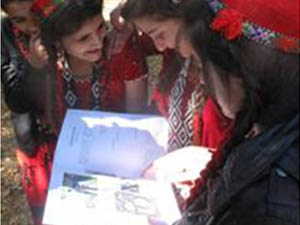 © Jamila Haider © Jamila Haider
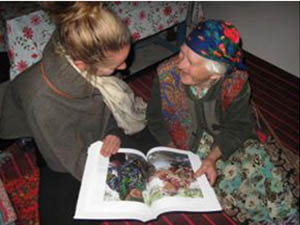 Initial reactions were often of surprise and sheer glee! © Frederik van Oudenhoven Initial reactions were often of surprise and sheer glee! © Frederik van Oudenhoven
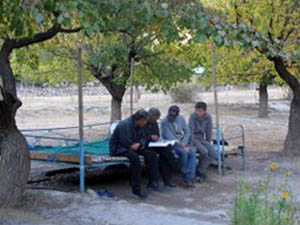 © Jamila Haider © Jamila Haider
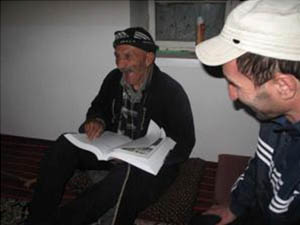 Akorbirsho, the father of a good friend and ethno-botanist collaborator, read the first recipe he recognised “Noshkukpa” and started howling with laughter. He then went through every page of the book. Akorbirsho, the father of a good friend and ethno-botanist collaborator, read the first recipe he recognised “Noshkukpa” and started howling with laughter. He then went through every page of the book.
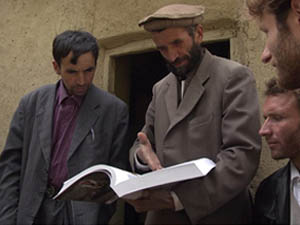 Frederik and schoolteachers in the Darmorakht Afghan Pamirs © Daan Jongbloed Frederik and schoolteachers in the Darmorakht Afghan Pamirs © Daan Jongbloed
|
